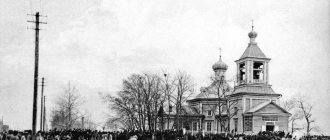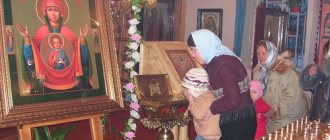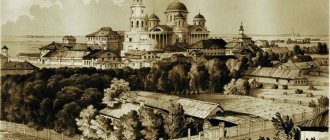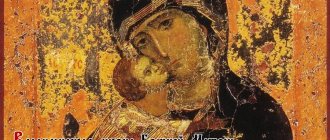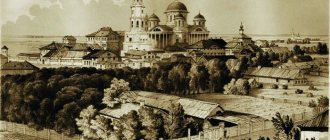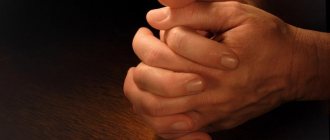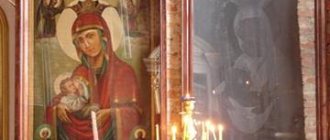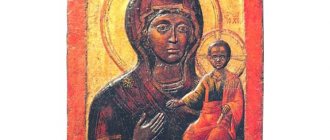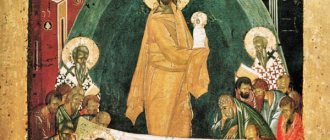Holy images associated directly with Christ himself are of great importance for Orthodox Christians. And here the Korsun Icon of the Mother of God is, of course, one of the most valuable shrines, which allows everyone to practically touch the times of the Savior himself. After all, according to legend, this image was painted by the Apostle Luke himself (who is considered the founder of the icon painting tradition as a whole) and was approved by the Mother of God herself, who called the image being under the blessing of herself and Christ.
Date of celebration: October 22
History of the appearance of the image
It is believed that the author of the Korsun icon is the Apostle Luke. For a long time after painting, the icon was kept in Ephesus. In the significant year for Rus' 988, October 9, the list from the ancient image was transferred from Korsun to Kyiv. The shrine, which arrived in Rus', began to be called Korsun. Over time, the list ended up in Novgorod. During the reign of Ivan the Terrible, a true Orthodox Christian, the face was brought to Moscow and placed in the altar of the Assumption Cathedral in the Kremlin.
The image is still located behind the altar of the cathedral. As a result of research, it was established that this shrine is a poorly studied example of ancient icon painting. The image became one of the main shrines of the temple. It has been kept in his altar for more than six centuries.
According to the second legend, the icon of the Queen of Heaven came from Greece to Russia in 1162 through the efforts of St. Euphrosyne (Polotsk). The saint received this name after becoming a monk. Before her tonsure, her name was Predislava, she was the daughter of the Polotsk prince. Thanks to the saint, a convent was founded in Polotsk, in which Euphrosyne was the abbess. Around 1162, she built a temple to the All-Merciful Savior.
The author of the Korsun Icon is the Evangelist Luke
When the saint learned that in Greece there were icons that were painted by the Evangelist Luke a thousand years ago, she sent generous gifts to the emperor and patriarch and asked to send her the image. The shrine was transferred to Rus' from Ephesus. The road went through Korsun, and the image remained in that city for about a year at the request of local residents. The icon that arrived became known as the Korsun icon. It was decorated with precious metals and stones. It was placed in the Temple of the Queen of Heaven and remained there for about 60 years. During this time, numerous miracles occurred from her, people received healings.
In 1239, the wife of St. Prince Alexander Nevsky transported the shrine to Toropets. There she was placed in the Cathedral of the Virgin Mary. Miracles did not stop happening from the icon. The image became especially famous for the defense of the Russian people from the attack of the Poles in 1611.
In 1917, after the bloody revolution, the Bolshevik government moved the shrine to St. Petersburg. In the Northern capital it was placed in the Russian Museum. And in Toropets there is a list of the miraculous image.
The date of celebration of the icon is October 9/22. According to the first legend, on this day she was delivered from Greece to Kyiv.
Day of Remembrance
October 22 is the day when all Orthodox believers, together with their families, friends and small children, go to church to kneel before the miraculous icon of the Mother of God. They light candles for health, prosperity, peace and prosperity. They read a prayer, an akathist, glorify the Intercessor, confess and undergo the rite of communion.
It is on this day that the power of the icon doubles and when you bring it home you can immediately feel its power. Cleanse your home of evil spirits, constant conflicts, let only joy, kindness, generosity, prosperity and love reign in it.
Meaning and description of the holy image
Iconographically, this image belongs to the Tenderness type. The shrine depicts the Queen of Heaven and Jesus pressing their cheeks to each other. This indicates how the human soul strives for God. It is believed that the Most Holy Theotokos symbolizes the soul of every person, striving for the Savior and wanting to be reconciled with Him.
Date of celebration of the icon – October 9/22
The color of the clothes of the Blessed Virgin Mary and the Child of God also has special symbolism:
- blue – Kingdom of Heaven;
- red – royalty, greatness;
- green - good news.
The God-Infant holds a scroll in one hand, which can be understood as the Gospel. With his other hand the Savior touches the cover of the Most Pure One. There is also a variant of the icon without the image of a scroll.
The Korsun image of the Most Pure One is very similar to the Kasperov icon. There is a version according to which the Kasperov icon is only a copy of the Korsun image. Folk memory has preserved cases of mirror copying.
What do they ask for before the miraculous Korsun Icon of the Mother of God?
It is believed that turning to the Korsun Icon helps in the most difficult circumstances. The Most Holy Theotokos in front of her Korsun image is asked:
- about easy labor and the birth of a healthy child;
- about family well-being;
- about getting rid of loneliness and starting a family;
- help in finding a job;
- get rid of material difficulties.
Prayer in front of the image helps to cope with despair, lack of faith in one’s strength, and get rid of melancholy and despondency. The Most Holy Virgin will come to the aid of the sincere prayer book and strengthen faith in those who doubt.
What does the Korsun icon help with?
There are no icons of the Most Holy Theotokos, in front of which one can pray only for certain needs, without having the right to other requests and praise. However, it so happens that people pray in front of some images for specific needs. They resort to the Korsun image with prayer:
- about the consolation of mental suffering;
- about saving children and relatives, instructing them on the path of salvation;
- about healing from illnesses.
Molebens are served in front of the icon, akathists, troparia, and prayers are read and sung. The main thing in prayer is repentance and sincerity, lack of consumerism. Prayer of thanksgiving and doxology are valuable.
The Korsun image of the Most Pure One is very similar to the Kasperov icon
Korsun Icon of the Mother of God, revealed in the city of Usman
Korsun Icon of the Mother of God
On October 22, a celebration takes place in honor of the Korsun Icon of the Mother of God, one of the miraculous copies of which resides in the Usman Epiphany Church.
The miraculous image of the Most Holy Theotokos, revealed in the God-saved city of Usmani, became famous for its gracious help in the successful birth of children. Every Saturday, before the beginning of the all-night vigil, an akathist singing is performed in front of the shrine with anointing from the lamp at the miraculous image.
Brief information about the icon first appeared in print in 1861. With reference to local tradition, it was reported that the icon was removed from the “Cathedral Pantry” after the Most Holy Theotokos appeared in a vision to a certain woman and told her the location of the image. The icon was placed on a special lectern in the church, and miracles began to attract many pilgrims.
In 1863, the rector of the Epiphany Cathedral, Archpriest. Vasily Nikolsky reported information about the icon, recorded from the words of the Voronezh bourgeois Mavra Savvina Burlakova who found it. The Burlakovs' daughter Anisya had trouble giving birth to children (6 stillborns). The family did not know any other way to help the grief than to pray tearfully.
In 1853, on the 3rd week of Lent, Mavra appeared in a dream vision “as if a woman known to her” with the words “go to the city of Usman to the Korsun Icon of the Mother of God, Who heals many there”; The woman held the icon itself in her hands. The messenger who visited Usman did not find an icon with that name in the cathedral. In May 1854, Mavra (in a dream vision she saw a voice that reproached her for the delay) and her daughter went to Usman.
They were able to find the icon standing among many images on the window, near which funeral services were being held. Mavra recognized it as the icon shown in the vision; it was called “Korsunskaya” by its signature. The first prayer service was served before the icon. The women told their story to Archpriest Alexy Lastochkin, begging him to give them the icon in Voronezh so that they could cover it with a chasuble in gratitude.
During the stay of the Korsun Icon in Voronezh, Anisya was able to safely deliver her pregnancy. The rector of the Voronezh Smolensk Church, Archpriest Pavel Esmansky, witnessed the miraculous event. The glorification of the icon began in Voronezh; prayer services were held in front of it in the Burlakovs’ house; Usman heard rumors about healing from the image. A copy of the icon was made, decorated with a frame. On September 29, 1855, the miraculous icon was returned to Usman.
The Korsun icon in the city of Usman of “simple Greek work” was written on a board. According to the testimony of the guard of the Epiphany Cathedral, Stepan Averyanovich, the icon belonged to a resident of Usman, Major Alexei Feodorovich Vishnevsky, who received it as a blessing from Metropolitan Platon Levshin; after the death of the major in 1826, she ended up in the temple. (Nikolsky. 1863. pp. 8–11; aka. 2007. 8–14).
A notable feature of the icon is the loss on the face of the Mother of God in the area of the right eye, which was formed through an oversight in Vishnevsky’s house due to a burn from a candle. As in the case, for example, with the Iveron Icon, the wound on the face became an iconographically reproduced feature in the copies of the Korsun Icon. The height of the icon was 38.9 cm (7 and 1/4 inches). The type of execution is close to Kasperov's icon.
In 1862, the spiritual authorities became aware of the Korsun Icon, and St. Feofan (Govorov), Bishop of Tambov, blessed her glorification. In 1863, during the renovation work of the Refectory Church, the right, Tikhvin, chapel was consecrated in honor of the Korsun Icon of the Mother of God (Oct. 5). Akathist singing was established on Thursdays after Vespers.
Several copies were made of the miraculous icon. The first one was written in Voronezh in 1855 before her return to Usman. In 1869, for the Epiphany Cathedral, another copy was made on a cypress board, which was placed in the first icon case of the miraculous image. In 1878, the clergy of the Epiphany Cathedral and the townspeople presented this list as a gift to the 11th Phanagorian Grender Regiment of Generalissimo Prince Suvorov, in honor of the victory in the Russian-Turkish campaign (a corresponding dedicatory inscription was made on the back). In 1874, Moscow resident A.V. Voronina donated a copy of the Korsun icon in a silver and gilded robe to the Epiphany Cathedral in gratitude for the birth of a child after multiple unsuccessful births (the icon was released for prayer services to residents).
In 1884, along with a new chasuble, another copy of the Korsun Icon was ordered from Moscow. The decoration made for the icon in 1869 was transferred to it: a silver frame (re-gilded and decorated with stones) and a “rosewood” icon case; the list was placed on the lectern of the Refectory Church, fenced with a lattice. This icon became a substitute for the miraculous image, which was released into homes for prayer services. In 1885, residents of Demshinsk, Usmansky district, ordered in Moscow a copy of the icon on a cypress board, decorated with a silver, gilded chasuble, made at Khlebnikov’s company; On the robe there was an inscription of gratitude, mentioning the deliverance of Demshinsk from cholera in 1871.
The decoration of the icon was updated several times. In 1855, the icon was returned from Voronezh, decorated, according to the promise of Mavra Burlakova, with a gilded silver chasuble with the same crowns, enclosed in a polished wooden icon case. In 1869, a new icon case was made, where the Korsun icon was transferred: from mahogany, “pasted with rosewood, with silver angles, cast under glass, with silver carvings” (Nikolsky. 2007. pp. 59-60). In 1884, a golden chasuble with enamels and a silver icon case under a bronze gilded canopy were made at Khlebnikov's Moscow company, ordered from donations from parishioners; The maforium of the Mother of God was decorated with a “diamond star”; a star and a cross made of stones were placed above the icon case.
Initially, the icon was located on a lectern between the altars of the Refectory Church; in 1884 it was placed in an icon case under a canopy on the right side of the altar.
The Korsun Icon had a sacristy with donated liturgical vestments for serving before the miraculous icon.
Since 1869, they were worn during a religious procession (established at the request of city merchants) under a specially constructed canopy from the cathedral to the shopping arcade on the 3rd day after Pentecost.
In 1871, the Korsun icon was carried around Usman and the villages of Usman and Zadonsk districts in connection with the cholera epidemic.
The clergy of the Epiphany Cathedral kept a record of “the actual facts of the signs of the Mother of God from Her revered Korsun icon.” In total, up to 1886, 17 cases of healing were recorded in detail; the massive scale of cases of relief during illness is emphasized, for example, in the summer of 1886 alone there were at least 100 such cases. “Detailed handwritten description of phenomena and miracles” from the Korsun icon, owned by Archpriest. Archbishop Dimitry (Sambikin) also mentions V. Nikolsky (Dmitry (Sambikin). Monthly Book. Issue 2. (Oct.). P. 62). In 1892, an investigation was carried out into cases of healing; after a secondary study, in 1901 statements with evidence of miracles were transferred to the Spiritual Consistory of the diocesan administration (Nikolsky. 2007. P. 54).
In the 30s XX century the temple was destroyed, the Korsun icon disappeared. In 2000, a decision was made to restore the Epiphany Church (founded in 2002). July 16, 2001, on the eve of the celebration of the holy royal passion-bearer Imp. Nicholas II, imp. Alexandra, Tsarevich Alexy, Grand Duchesses Olga, Tatiana, Maria, Anastasia, the Korsun Icon was miraculously found. Since 2001, the procession of the cross has been held with the miraculous icon.
The first religious procession in honor of the Royal Martyrs took place on July 17, 2000. It passed around the city of Usman along outlying streets and bypass roads and had a length of about 23 km. Lasted more than 5 hours.
Subsequent annual religious processions took place (and take place today) around the historical center of Usman, a length of about 8-9 km. lasts 2.5 hours.
In 2009, during the procession of the Cross, the miracle of the appearance of the Cross (from the clouds) in the sky was witnessed.
Since 1998, on October 22, a traditional religious procession has been held in memory of the Korsun Icon of the Mother of God. It starts simultaneously from two churches in the city of Usman (Uspensky and Epiphany), runs along the central streets to the square, where after the meeting of the religious processions a solemn prayer service is served.
Since 2003, the tradition of reading the Akathist to the Mother of God of Korsun on Saturdays before the start of the evening service has been renewed.
The icon is installed in the upper church to the right of the altar. It is located in a wooden carved icon case with a canopy, made in 2004 based on a surviving photograph from the early 20th century. The icon is decorated with a gilded chasuble with pearls, made at the Sofrino KhPP in 2009.
Literature : Khitrov G. Ist.-stat. description of the Tambov bishop. Tambov, 1861. P. 315; Nikolsky V., prot. // Tambov EV. 1863. No. 21 (November). P. 637; aka. Korsun Icon of the Mother of God in the Cathedral Church of the Epiphany in the city of Usman, Tambov province. K., 1907 (same in the book: Korsun Icon of the Mother of God in the Cathedral Church of the Epiphany in the city of Usman, Tambov province. Teachings and speeches of Archpriest V. Nikolsky. Zadonsk, 2007); Index of local Tambov festivities. Tambov, 1876. P. 34; Months of the Saints, RCs Honored // Add. to Tambov EV. 1878. Issue. 1; Tambov EV. No. 43. 1881; Snessorev. Earthly life of St. Mother of God. St. Petersburg, 1892. P. 339; Benediktov P.I. About the miraculous and locally revered holy icons of the Tambov region. Tambov, 1902; Villager. Our Lady. P. 642.
Where is the holy face
The ancient icon, brought to Rus' at the beginning of the second millennium, is now kept in the Russian Museum in St. Petersburg. Despite the fact that the image is not in the temple, Orthodox Christians go to the museum building to bow, venerate the shrine and pray. The museum's caretakers are accustomed to large numbers of pilgrims. This icon is a blessing for the city and the whole country.
There are also several ancient lists in other cities:
- Nizhny Novgorod, Annunciation Cathedral (one of the most ancient lists, dated 995, is kept here);
- Glinkovo, in the area of the Trinity-Sergius Lavra;
- Smorigi, Smolensk region, St. Nicholas Church.
There are many temples consecrated in honor of this image. Today, the images created by icon painters have replaced modern printed images. Every Orthodox Christian can buy himself a Korsun icon in a church shop.
You should not be skeptical about modern icons, because there are known cases of paper images of saints streaming myrrh. The main thing is the sincere faith of the person praying.
Author's advice
Church in Uglich
Skete of the Holy Trinity-Paraskevievsky Toplovsky Convent on Sapun Mountain
Cathedral in Toropets
The Apostle and Evangelist Luke became the first icon painter
The Apostle and Evangelist Luke paints an icon of the Mother of God.
The custom of painting icons, according to legend, came from the Apostle Luke. The legend tells us that the apostle wrote the first image of the Mother of God on the table board with her permission. Then the holy apostle painted several more icons. By the way, “icon” means “image” or “image”.
Prayer before the image of the Virgin Mary
O Most Holy Virgin, Lady Theotokos, the Only Begotten God of the Word, all visible and invisible creatures, Creator and Master, one of the Trinity, Lord, God and Man, who gave birth more than nature and words, the Divine receptacle, the recipient of all shrines and graces, in Neizha the fulfillment of the Divine abides , by the blessing of God and the Father and the action of the Holy Spirit, chosen from all creation, glory and unspeakable joy of the Angels, the royal crown of the apostles and prophets, the wonderful and all-praiseworthy courage of the martyrs and the wedding of sufferers, everlasting and incorruptible rewards to the immutable intercessor, honor and glory to the venerables, unforgettable path to the teacher , source of light, inexhaustible river of mercy, inexhaustible sea of all miracles and spiritual gifts!
We pray to You and ask You, merciful Mother of the Lover of Mankind, to have mercy on us, Your humble and unworthy servant: look mercifully on our captivity and heal the contrition of our souls and bodies, destroy the visible and invisible armies, and every pillar of the fortress, weapons in battle, commander and invincible champion, make us unworthy on behalf of our enemies. Show us Your ancient mercies and wonders. For there is only one King and Master, Thy Son and God, and Thou art truly the Mother of God, blessed of all generations, who gave birth to the true God according to the flesh, and for His sake Thou art all able and mighty to act, even if thou wilt in heaven and on earth.
Fulfill every request for the benefit of everyone, Lady: grant healing to those who are ailing, silence and control to those floating in the sea, travel and observe with those who travel, console those who grieve, ease poverty and all bodily bitterness, consume mental illness and bodily passions first of all through Your invisible intercession and by intercession, so that we may end this temporary path of life kindly and without stumbling, and receive eternal good for Your sake in the Kingdom of Heaven.
Much more than this, entrusted to You, this city and every city and country from famine, destruction, cowardice, flood, fire and sword, from the presence of foreigners and internecine warfare and from vain death, and from righteous death, turn away all anger righteously moved towards us, by the good will and grace of the Only Begotten Son Yours, to Him belongs all glory, honor and worship, with His Originless Father and the Ever-Existing and Life-Giving Spirit, now and ever and unto ages of ages. Amen.
The icon of the Mother of God of Korsun is one of the most ancient. The Russian people are God-bearers, and strong faith and trust in the help of the Lord and the Most Pure One have always protected the country from enemies. Holy images of the Mother of God are a blessing to the Russian land. The Most Holy Theotokos hears the prayers of everyone who comes running to her with faith and repentance, and intercedes for the one praying before the Lord.
If you find an error, please select a piece of text and press Ctrl+Enter.
Lists are copies of icons, miraculous icons are a source of healing and grace
Every pious Christian who had the opportunity to personally talk with the Mother of God imprinted her image in his heart. Of course, he wanted to show it to his brothers in the city or country where he was from.
Therefore, from the first icons painted by the Evangelist Luke, they began to make copies, or copies. These lists were brought by pilgrims to the most remote corners of the earth.
People prayed in front of the holy image, and the Mother of God answered them with her intercession.
Obvious miracles and healings took place in front of the icons.
Believers began to glorify the Mother of God in chants and prayers, and the icons in front of which miracles occurred were called miraculous.
Very often the name of the area where the miracle happened was added to the name of the icon. Christians carefully preserved these events and passed them on from generation to generation.

